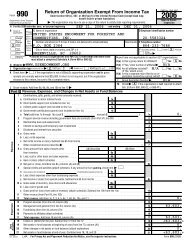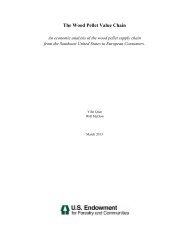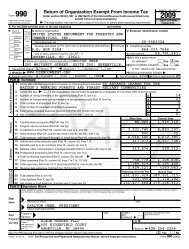The State and Future of U.S. Forestry and the Forest Industry (May ...
The State and Future of U.S. Forestry and the Forest Industry (May ...
The State and Future of U.S. Forestry and the Forest Industry (May ...
Create successful ePaper yourself
Turn your PDF publications into a flip-book with our unique Google optimized e-Paper software.
When separating out <strong>the</strong> nanocellulose category from all types <strong>of</strong> nanomaterials shown in Table 2 <strong>and</strong> projectingconservative levels <strong>of</strong> market penetration for products, <strong>the</strong> figures for jobs <strong>and</strong> values remain impressive (see Table3). For example, at a demonstration-scale, nanocellulose technology can deliver 500 annual tons per 50 employees.Economies <strong>of</strong> scale <strong>and</strong> fur<strong>the</strong>r technology development will drive this to 500,000 tons per 1,000 employees.<strong>The</strong>refore, <strong>the</strong> first 8 million tons <strong>of</strong> dem<strong>and</strong> potential for cellulosic nanomaterials could conservatively represent16,000 direct jobs <strong>and</strong> 64,000 total new manufacturingjobs (using an indirect factor <strong>of</strong> 3). Fur<strong>the</strong>r, it isprojected that cellulosic nanomaterial utilizationcould be as high as 3-4 percent across <strong>the</strong>se targetmarkets building to over 24 million tons <strong>of</strong> dem<strong>and</strong>.This potential 24 million tons <strong>of</strong> dem<strong>and</strong> could driveas many as 224,000 jobs <strong>and</strong> a potential GDP finalproduct value <strong>of</strong> over $100 billion in <strong>the</strong> United <strong>State</strong>s-- as projected by <strong>the</strong> NNI <strong>and</strong> National ScienceFoundation study.Table 3: Jobs <strong>and</strong> GDP Projections for Wood-basedNanotechnologyMarketPenetrationProductionTonsDirect JobsManufacturingJobsGDP1% 8 million 16,000 64,000 $10 billion3% 24 million 74,000 224,000 $100 billionSource: National Nanotech Institute/National Science Foundation 15Measures <strong>of</strong> SuccessGeneral measures <strong>of</strong> success fall into three broad areas. First is market growth: <strong>the</strong> forestry sector shouldexperience restored <strong>and</strong> growing domestic <strong>and</strong> export markets in which better informed suppliers <strong>and</strong> consumersare engaged in a two-way dialogue about traditional <strong>and</strong> newly emerging products made from wood. Second isenhanced R&D investment: <strong>the</strong> forestry sector will demonstrate increased investment in research <strong>and</strong> productdevelopment <strong>and</strong> improvements that open currently restricted markets, increase raw material utilization, <strong>and</strong>appeal to a younger, more diverse, <strong>and</strong> broader customer base. Finally is an improved regulatory <strong>and</strong> policyenvironment: through increased cooperation in <strong>the</strong> entire forestry sector, a governmental regulatory <strong>and</strong> policyenvironment evolves that recognizes <strong>the</strong> environmental benefits <strong>of</strong> wood, provides a greater degree <strong>of</strong> certaintyabout <strong>the</strong> timing <strong>and</strong> level <strong>of</strong> capital investment needed to meet regulatory requirements, <strong>and</strong> rewards production,utilization, <strong>and</strong> manufacturing efficiencies.Action Items—General <strong>The</strong>mesRetaining <strong>and</strong> exp<strong>and</strong>ing markets for wood-based products will require three broad categories <strong>of</strong> activities: (1)increased marketing activities designed to exp<strong>and</strong> markets for traditional products <strong>and</strong> develop markets for new ornontraditional products; (2) increased research <strong>and</strong> development activities devoted to new product development,better raw material utilization, <strong>and</strong> breaking down market access restrictions; <strong>and</strong> (3) an increased commitmentto public <strong>and</strong> government affairs work to exp<strong>and</strong> a policy environment favorable to <strong>the</strong> use <strong>of</strong> wood as anenvironmentally preferred product.Action Items—SpecificsEach <strong>of</strong> <strong>the</strong> broad action areas listed above will require detailed action plans <strong>and</strong> budget outlays. Some <strong>of</strong> <strong>the</strong> keyactions should include <strong>the</strong> following.Increased Marketing Activities• <strong>The</strong> paper industry should move as quickly as possible to pass <strong>and</strong> implement its market check-<strong>of</strong>fprogram.• <strong>The</strong> hardwood industry should follow suit in moving its program forward.• <strong>The</strong> timber harvesting <strong>and</strong> wood-to-energy sectors should each seriously consider <strong>the</strong> question <strong>of</strong>pursuing a check-<strong>of</strong>f program.• As multiple check-<strong>of</strong>fs are adopted, each governing board should join in a coordinating committee with<strong>the</strong> s<strong>of</strong>twood lumber check-<strong>of</strong>f board to compare <strong>and</strong> coordinate check-<strong>of</strong>f activities. <strong>The</strong> coordinatingcommittee should meet at least quarterly to discuss check-<strong>of</strong>f supported marketing initiatives <strong>and</strong>1See also Michael C. Roco, Chad A. Mirkim, <strong>and</strong> Mark C. Hersam, “Nanotech Research Direction for Societal Needs in 2020: Retrospective <strong>and</strong> Outlook,” available at http://www/wtec.org/nano2





